The Art And Architecture Of Yorubaland! - Culture (5) - Nairaland
Nairaland Forum / Nairaland / General / Culture / The Art And Architecture Of Yorubaland! (128368 Views)
A Short History Of Yorubaland With Pictures / Art And Architecture Of The Igbo People / Benin Art And Architecture (2) (3) (4)
(1) (2) (3) (4) (5) (6) (7) (8) (9) (10) ... (16) (Reply) (Go Down)
| Re: The Art And Architecture Of Yorubaland! by PhysicsQED(m): 7:47pm On Oct 02, 2011 |
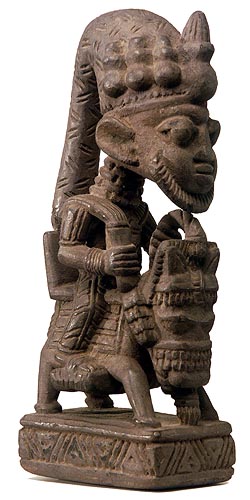 YORUBA, HORSEMAN 5, 11" Nigeria Figures were placed on altars in shrines or displayed at special ceremonies. Leaders and ancestors were often displayed on horseback to support their status as great warriors or leaders. several are depicted in colonial wear. Despite its patina, this figure shows no evidence of age or use and was probably made to be sold. |
| Re: The Art And Architecture Of Yorubaland! by PhysicsQED(m): 7:49pm On Oct 02, 2011 |
 Nigeria - Yoruba Epa Headdress (British Museum) Nigeria Yoruba people Probably late 19th century Possibly carved by Bamgose of Osi-Ilorin The Epa masquerade of the Yoruba peoples promotes the health and well-being of communities. Processions of masqueraders perform energetic dances which suggest higher powers of existence and the strengthening of the body. The performers jump to the top of a mound, the result of which is an omen for the community. In Opin such masks were known as aguru and were used in the post-burial rites of titled men whose status was based on personal achievement rather than lineage. The image of the mounted warrior appears regularly on Epa masks. In addition to being an image of energy and authority, it embodies memories of at least three centuries of cavalry warfare in north-central Yoruba. H.M. Cole (ed.), I am not myself: the art of ma, Los Angeles monograph series, no. 26 (Museum of Cultural History, University of California, 1985) T. Phillips (ed.), Africa, the art of a continent (London, Royal Academy, 1995) |
| Re: The Art And Architecture Of Yorubaland! by PhysicsQED(m): 7:56pm On Oct 02, 2011 |
[img]http://scma.smith.edu/artmuseum/var/scma/storage/images/artists/yoruba-peoples-unknown-artist/agere-ifa/2073-1-eng-US/Agere-Ifa_large.jpg[/img] Unknown artist. Yoruba peoples, Nigerian Agere Ifa, 19th-20th century Curator‘s Comments An agere Ifa is one of the essential ritual artifacts used by divination priests. When an individual or group consults an Ifa priest with a problem, the diviner uses sixteen sacred palm nuts to “cast Ifa” and produce images for the client. This agere Ifa was carved by a master carver, and has an intricate grouping of seven figures and a horse. In the faces of the equestrian figure and the mother with child, the carver has reflected the desires of the people consulting the priest, and has provided visual expressions of hope and expectation. |
| Re: The Art And Architecture Of Yorubaland! by PhysicsQED(m): 7:59pm On Oct 02, 2011 |
 An impressive, beautifully rendered Agere Ifa Sculpture of a Horse and Rider Divination Cup. Mid 20th Century. Camwood and Indigo (or Rekitts Blue) coloring. Height: 15.5 inches (39.5cm), Length: 12.5 (31.5cm), Width: 5 inches (12.5cm). There are a few stable cracks, otherwise in good condition. |
| Re: The Art And Architecture Of Yorubaland! by PhysicsQED(m): 8:01pm On Oct 02, 2011 |
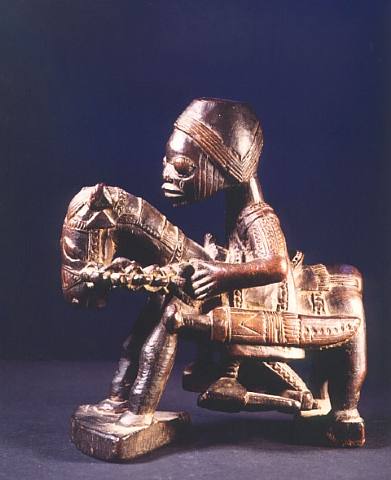 TITLE: Yoruba Horseman, (Section of an Ifa divination cup) SIZE: h: 8.2 in / h: 20.8 cm REGION: African TRIBE: Yoruba PRICE*: Contact Gallery for Price GALLERY: 310-820-9448 Send Email DESCRIPTION: Although they are objects firmly associated with ritual, Ifa divination cups, agere Ifa, have few proscriptions regarding subject matter and manner of execution. As a result they vary widely in form and representation, and have provided Yoruba carvers with a versatile sculptural type with which to test their skill and imagination. The equestrian figure, embodying as it does notions of power, of sacrifice and self-discipline, was often the subject of the agere Ifa, especially among the central and northern Yoruba carvers, where the mounted warrior was better known. The figures are said to personate Obatala (The King who is great), "The Deputy Olodumare" (or Olorun, The High God), "The Maker", "The One who deals in choice clay". Obatala is the heavenly rider, represented as a horseman or a mounted figure holding a lance or carrying a sword and scabbard. In addition, the actual process of carving, the skill and imagination of the master carver, serves as a hymn of praise to the deity. The curve of the horse's neck, the line of the rider's jaw and the bend of the foot in the stirrup give evidence of the carver's sense of figural form. The harness, reins and scabbard are finely detailed. But these skills of eye and hand are subordinated to an awareness of the unity of the work as a whole. ONLINE CATALOGUE(S): African & Asian Art LITERATURE: Drewal, Pemberton and Abiodun, Yoruba - Nine Centuries of African Art and Thought, the Centre for African Art in association with Harry N Abrams, New York, 1989. |
| Re: The Art And Architecture Of Yorubaland! by Nobody: 8:03pm On Oct 02, 2011 |
I dont remember having horses in the Yoruba culture. So can someone explain all the horse riders?  |
| Re: The Art And Architecture Of Yorubaland! by PhysicsQED(m): 8:06pm On Oct 02, 2011 |
I found an interesting image of another agere ifa sculpture: [img]http://academics.smcvt.edu/africanart/Arianne%20Pictures/agere%20vessel.jpg[/img] Ifa Divination Vessel: Equestrian Warrior (Agere Ifa) Yoruba, Nigeria Wood; H. 29.5 cm (11 5/8 in.) 19th century Museum für Völkerkunde zu Leipzig Maf22514 In Yoruba culture, women and men each have their own characteristics that make them powerful. Metaphorically, women and men can be compared to containers and what needs containing. Women are vessels in more than one sense. They carry babies, and they also receive men during intimate intercourse. In this way, women have a power that men need. This is an essential concept of female power that is brought out through the art. (4) Vessels and receptacles are traditionally associated with women for two purposes: they are symbolic and actual containers, and they are reliable and productive. According to a legend, a woman named Agere was a divination deity’s wife who protected him by hiding him in her belly and also helped him by working with him. Agere containers, which are divination vessels that hold a young male initiate’s palm nuts (contain) and that are also used to ground medicines (productive), became known as such due to this woman. (4) Although associated with women, instead of images of females, the agere containers are usually carved in the form of men on horseback, like this one pictured here. (4) (4) Drewal, Margaret Thompson. Yoruba Ritual: Performers, Play, Agency. Bloomington and Indianapolis: Indiana University Press, 1992. |
| Re: The Art And Architecture Of Yorubaland! by PhysicsQED(m): 8:15pm On Oct 02, 2011 |
Another agere ifa figure. This one is really cool looking and also reveals what the attire of the horsemen looked like:  Estimation : 20 000 - 24 000 € Lot n°181 Yoruba, Nigeria. Coupe Agere Ifa. Cette coupe en ivoire est destinée à recevoir les noix de palmes utilisées dans les rituels de divination du culte Ifa. Le réceptacle, au bord dentelé, est disposé au sommet du crâne dÕun cavalier. Celui-ci à lÕallure guerrière est richement habillé, costume et harnachement sont sculptés avec détails. Le cavalier assis sur une selle au haut dossier protecteur, porte en main droite un bâton, la main gauche absente devait tenir la bride du cheval. Cette représentation équestre évoque les valeurs de Mesi Shango, guerrier mythique, libérateur du peuple yoruba, divinisé par la suite comme Dieu du tonnerre. LÕensemble équestre repose sur un plateau circulaire aux bords décorés dÕune ligne brisée. LÕivoire présente une patine brun rouge très foncé par endroits, et particulièrement luisante en croupe. Des gerces anciennes, expliquent les brides en cuivre qui ont été fixées à la base et en intérieur de la coupe afin dÕen limiter les effets dÕécartements. On note au dos du biceps droit un manque parallèle à la gerce principale. Ce type de coupe apparaît au début du XIX siècle évoquant et commémorant les guerriers chasseurs du XVIII siècle des seize royaumes. Région d'Owo. Dimensions : 24,5 cm de hauteur le diamètre à la base au plus fort est égale au diamètre de la partie supérieure de la coupe soit 12,5 cm cm ^^^ Don't know what any of that means, but it seems to be from the 19th century (siècle) according to the Roman numerals used. Does anyone who knows French know what it's saying above about the baton or Shango? http://www.enghien-svv.com/html/fiche.jsp?id=673074&np=1&lng=fr&npp=20&ordre=1&aff=1&r=agere+ifa |
| Re: The Art And Architecture Of Yorubaland! by lakal(m): 8:26pm On Oct 02, 2011 |
@Ileke_idi -- horses were very prominent in the Savanna regions of Yorubaland, epecially Oyo. Horses were closely tied to Kings and nobility, and were the symbols of the Oyo Empire's might. Only the very wealthy could keep horses as most of Yorubaland is inhospitable to the horse because of the tsetse fly. Therefore, horses were an expensive prestige object. It was horses that allowed Oyo to aggressively expand. Remember Wole Soyinka's play Death and the King's Horseman? That is one instance of the importance of the horse to the culture of (Northwestern) Yorubaland. |
| Re: The Art And Architecture Of Yorubaland! by tpia5: 8:47pm On Oct 02, 2011 |
Calm down. Nobody could possibly claim Benin took precedence in lost wax casting, and I have seen other Ife art that actually was radiocarbon dated, so that's not even the point. There's a Benin thread and I'm not interested in diluting this thread with material or information that I've already seen. I was just pointing out that that particular piece hadn't been dated to a specific time, so seeing something as specific as "12th century" as it's label doesn't make sense and is almost arbitrary. I only even mentioned Benin to admit that the same was true of many of the Benin pieces, which are also undated, other wise I wouldn't have mentioned Benin. The basis of the assigned dates for most of them both was basically Frank Willett and William Fagg's ideas about the artistic progression of certain styles over centuries; there were few radiocarbon dates. the earliest ife bronzes are dated to around the 6th century. any comments on that?  |
| Re: The Art And Architecture Of Yorubaland! by tpia5: 8:50pm On Oct 02, 2011 |
what talented peoplec the Yoruba were in the past very true. that's why i wish we knew more about the artists who created those ife sculptures. the style and naturalism is simply amazing. |
| Re: The Art And Architecture Of Yorubaland! by tpia5: 8:52pm On Oct 02, 2011 |
An unusual tradition within African sculpture is the cast-metal work done from about the 12th century in what is now southern Nigeria. |
| Re: The Art And Architecture Of Yorubaland! by PhysicsMHD(m): 9:10pm On Oct 02, 2011 |
tpia@: If this is accurate, you should start a thread about it, or publish it somewhere. I was talking about radiocarbon dating of art cast with the lost wax method. Maybe you're talking about something else, like when Ife first showed signs of significant occupation. Anyway, if this is true, it doesn't really affect my earlier statement. I guess you could say I was nitpicking, and if that was annoying, then I apologize. |
| Re: The Art And Architecture Of Yorubaland! by tpia5: 9:11pm On Oct 02, 2011 |
"We wanted to make the point that nobody, when they learn European art history, studying Italy and Renaissance in the fourteenth, fifteenth centuries, is taught that at exactly the same time in West Africa, artistic production of the same level and the same quality is going on," he said during a talk on Nigeria at the museum. http://articles.cnn.com/2010-06-21/world/kingdom.ife.sculptures_1_ife-sculptures-african-art/2?_s=PM:WORLD |
| Re: The Art And Architecture Of Yorubaland! by PhysicsMHD(m): 9:13pm On Oct 02, 2011 |
. |
| Re: The Art And Architecture Of Yorubaland! by lakal(m): 9:27pm On Oct 02, 2011 |
Ifa Diviner's necklace (Ikolaba Ifa) [img]http://zoom.mfa.org/fif=sc8/sc8631.fpx&obj=iip,1.0&wid=568&cell=568,427&cvt=jpeg[/img] |
| Re: The Art And Architecture Of Yorubaland! by lakal(m): 9:29pm On Oct 02, 2011 |
Carved Yoruba calabash [img]http://hearstmuseum.berkeley.edu/exhibitions/maker/images/5_15649ab.jpg[/img] In Yoruba culture, the calabash is considered a container for items, both sacred and profane, but importantly is a symbol used when explaining the universe, which is considered to be a calabash (again, science concurs that the universe as we understand it is in essence an expanding sphere). In that role, the universe is cut in half with the upper half representing Orun (heaven) and the lower half representing earth or the “known” universe (aiye). This plays directly into our diagram of circle with two intersecting lines, the horizontal representing the differentiation between heaven and earth and subsequently life and death. 2 Likes |
| Re: The Art And Architecture Of Yorubaland! by lakal(m): 9:35pm On Oct 02, 2011 |
Another example of a carved calabash. [img]http://images.tribe.net/tribe/upload/photo/8a1/7c9/8a17c909-0045-4713-ac4f-365b8d4e36e9[/img] 1 Like |
| Re: The Art And Architecture Of Yorubaland! by tpia5: 9:42pm On Oct 02, 2011 |
^^what are the dates on those? the first calabash is very interesting. |
| Re: The Art And Architecture Of Yorubaland! by tpia5: 9:42pm On Oct 02, 2011 |
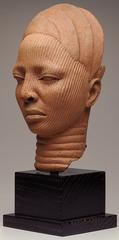 12th century |
| Re: The Art And Architecture Of Yorubaland! by lakal(m): 9:48pm On Oct 02, 2011 |
The first one was collected in the mid 20th Century, no notes on when it was made. The second dates from the 19th Century. |
| Re: The Art And Architecture Of Yorubaland! by lakal(m): 11:34pm On Oct 02, 2011 |
Modern palace entrance, Oyo.  |
| Re: The Art And Architecture Of Yorubaland! by tpia5: 4:00am On Oct 04, 2011 |
lakal: oh, ok. very nice designs i must say. |
| Re: The Art And Architecture Of Yorubaland! by lakal(m): 4:03am On Oct 04, 2011 |
Weaponry! Ceremonial and real   Origin: Nigeria Circa: 20 th Century AD Dimensions: 18" (45.7cm) high Collection: African Style: Yoruba Medium: Brass |
| Re: The Art And Architecture Of Yorubaland! by lakal(m): 4:05am On Oct 04, 2011 |
[img]http://t1.gstatic.com/images?q=tbn:ANd9GcR3UXBRVlXTHJVuV2bkHlwFAoGqrUfbyHe_ynKTR49a1d7NsZ2e[/img] Yoruba ceremonial swords. |
| Re: The Art And Architecture Of Yorubaland! by lakal(m): 4:08am On Oct 04, 2011 |
[img]http://t2.gstatic.com/images?q=tbn:ANd9GcTQ7kw4dA4EYCTnsoOmdfKi_hkMVeue1UPHR_xvsj_yoIohwYwLWg[/img] Yoruba Ivory ceremonial Sword (Udamalore) - GDC.019 Origin: Nigeria Circa: 1800 AD to 1920 AD Dimensions: 15.25" (38.7cm) high Collection: African Art Style: Yoruba Medium: Ivory Condition: Extra Fine |
| Re: The Art And Architecture Of Yorubaland! by tpia5: 4:08am On Oct 04, 2011 |
back to the ife sculptures, i think its quite strange so little information is available about them, even though they give a glimpse into yoruba life of centuries ago. how did leo frobenius first hear about ife? How and why did he go there? In 1911 a German ethnographer, Leo Frobenius visited Ile-Ife and discovered some sculptures that the local people dug up to use in religious rituals and then returned to the earth. The statues in bronze and terra cotta were so naturalistic that he did not believe that they were made by Africans. He insisted that he had discovered the remains of the lost Greek city of Atlantis. Study by other archeologists revealed that this art was the work of the Yoruba of Ile-Ife between 1000 to 1399 http://www.historywiz.com/galleries/artofbenin.htm the sculptures do have a greek feel to them, shown by the attention to detail, the calm expressions and highly naturalized form. seems to me like the yoruba artists who made them, had seen or been exposed to that type of art previously, and had developed it to astonishing detail. mauretania maybe?  and how did they do all this without a coded writing system and no formal math symbols that we know of?  |
| Re: The Art And Architecture Of Yorubaland! by lakal(m): 4:11am On Oct 04, 2011 |
Axe for Shango (Oshe Shango) [img]http://t1.gstatic.com/images?q=tbn:ANd9GcTzyBlCiz0pEUkzh2cbRPNoKQssGGy-ttJGKizO5XtpfPMPqZtj[/img] Oshe Shango Yoruba, Republic of Benin Wood, indigo, bluing, lime, ochre. Fowler Cultural Museum of History On this dance wand, Oshe Shango, is an image of a kneeling female balancing on her head the double headed ax, representing the power of Shango. This wand is carried by the devotees of the orisha (god) Shango, the thunder god, at the yearly festival for their god and at other ritual festivals. It is one's ori , representing both their head and personal destiny, to carry the great power of Shango upon their head. |
| Re: The Art And Architecture Of Yorubaland! by lakal(m): 4:17am On Oct 04, 2011 |
Yoruba-style Sword ("Ida"   1 Like |
| Re: The Art And Architecture Of Yorubaland! by lakal(m): 4:21am On Oct 04, 2011 |
BODY ART: As much as Yoruba people of today are (unfairly lol) "marked" as people who perpetuate tribal markings, some of the old school tribal marks/tattoos were rather interesting. 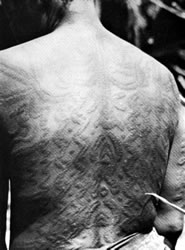 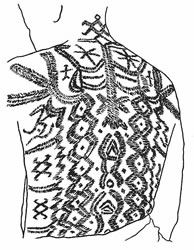 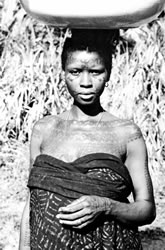 |
| Re: The Art And Architecture Of Yorubaland! by lakal(m): 4:23am On Oct 04, 2011 |
 A rare early C20th image of Yoruba women dyers with their clay dye pots. Vintage postcard, circa 1910, authors collection. (As mentioned before) Indigo was the foundation of numerous textile traditions throughout West Africa. For centuries before the introduction of synthetic dyes the ability to transform everyday white cotton into prized deep blue cloth was a mysterious and highly valuable skill passed on by specialist dyers from generation to generation. From the Tuareg nomads of the Sahara to the grassland kingdoms of Cameroon, indigo cloth signified wealth, abundance and fertility. Appropriately it was women who dyed cloth with indigo in most areas, with the Yoruba of Nigeria and the Manding of Mali (especially the Soninke /Malinke) particularly well known for their expertise. Yoruba dyers paid tribute to a patron deity, Iya Mapo to ensure the success of the complex dye process. |
| Re: The Art And Architecture Of Yorubaland! by lakal(m): 4:29am On Oct 04, 2011 |
tpia@: The Ife sculptures are a mystery. I often wonder if the earliest of the bronzes occurred during the lifetime of Oduduwa (if he was a real person). Frobenius getting credit for "discovering" the bronzes is once again European chauvinism. He heard about the bronzes from the Yoruba people, and knew where he was digging for the "Olokun" head -- he paid the guardian of the Olokun shrine money to dig up the head. 1 Like 1 Share |
(1) (2) (3) (4) (5) (6) (7) (8) (9) (10) ... (16) (Reply)
Traditional Eastern Ijaw Attire In Pictures / The True Extent Of Alaigbo (Igboland) / 18+ Unclad Photos Of African Women Slaves From The Past.
(Go Up)
| Sections: politics (1) business autos (1) jobs (1) career education (1) romance computers phones travel sports fashion health religion celebs tv-movies music-radio literature webmasters programming techmarket Links: (1) (2) (3) (4) (5) (6) (7) (8) (9) (10) Nairaland - Copyright © 2005 - 2024 Oluwaseun Osewa. All rights reserved. See How To Advertise. 69 |